Hotpoint Ariston WML 803B Manual [it]

Instructions for use
WASHING MACHINE
GB GR BG
English,1 ΕΛΛΗΝΙΚΑ,13 Български,25
Contents |
GB |
|
Installation, 2-3
Unpacking and levelling
Connecting the electricity and water supplies
The first wash cycle
Technical data
IT
Italiano,25
Care and maintenance, 4
Cutting off the water or electricity supply Cleaning the washing machine Cleaning the detergent dispenser drawer
Caring for the door and drum of your appliance Cleaning the pump
Checking the water inlet hose
Precautions and tips, 5
WML 803
General safety Disposal
Opening the porthole door manually
Description of the washing machine and starting a wash cycle, 6-7
Control panel Indicator lights Starting a wash cycle
Wash cycles, 8
Table of wash cycles
Personalisation, 9
Setting the temperature
Setting the spin speed
Functions
Detergents and laundry, 10
Detergent dispenser drawer Preparing the laundry Garments requiring special care Load balancing system
Troubleshooting, 11
Service, 12
1
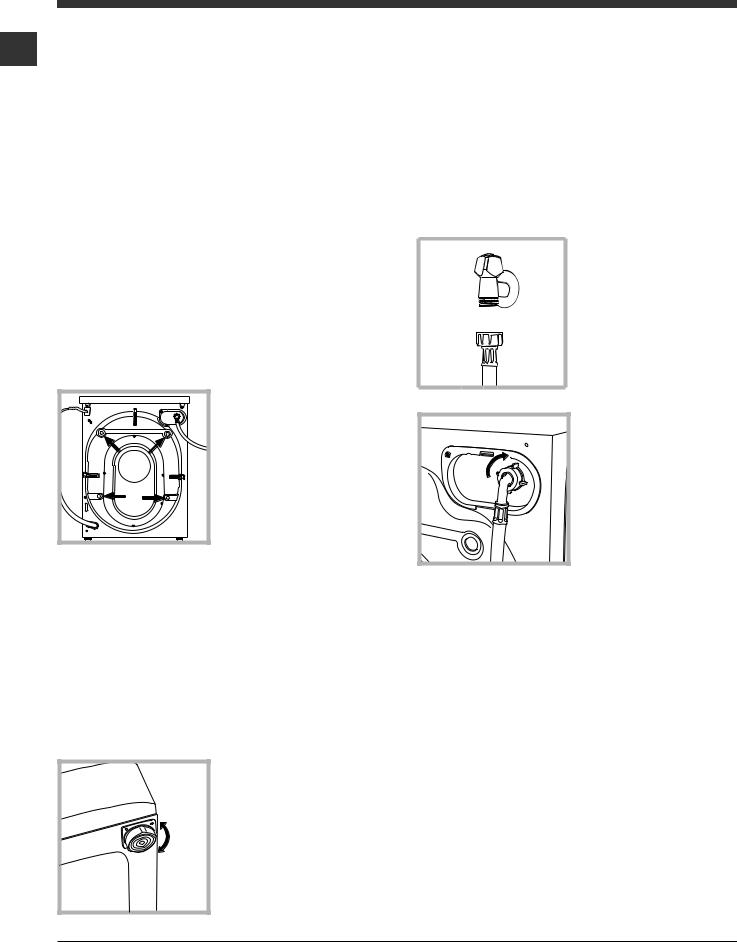
Installation
! This instruction manual should be kept in a GB safe place for future reference. If the washing machine is sold, transferred or moved, make sure that the instruction manual remains with the machine so that the new owner is able to
familiarise himself/herself with its operation and features.
! Read these instructions carefully: they contain vital information relating to the safe installation and operation of the appliance.
Unpacking and levelling
Unpacking
1.Remove the washing machine from its packaging.
2.Make sure that the washing machine has not been damaged during the transportation process. If it has been damaged, contact the retailer and do not proceed any further with the installation process.
3.Remove the 4
protective screws (used during transportation) and the rubber washer with the corresponding spacer, located on the rear part of the appliance (see figure).
4.Close off the holes using the plastic plugs provided.
5.Keep all the parts in a safe place: you will need them again if the washing machine needs to be moved to another location.
! Packaging materials should not be used as toys for children.
Levelling
1. Install the washing machine on a flat sturdy floor, without resting it up against walls, furniture cabinets or anything else.
2. If the floor is not perfectly level, compensate for any unevenness by tightening or loosening the adjustable front feet (see figure); the angle of inclination, measured in relation to the worktop, must not exceed 2°.
Levelling the machine correctly will provide it with stability, help to avoid vibrations and excessive noise and prevent it from shifting
while it is operating. If it is placed on carpet or a rug, adjust the feet in such a way as to allow a sufficient ventilation space underneath the washing machine.
Connecting the electricity and water supplies
Connecting the water inlet hose
1. Connect the inlet hose by screwing it to a cold water tap using a 3/4 gas threaded connection (see figure).
Before performing the connection, allow the water to run freely until it is perfectly clear.
2. Connect the inlet hose to the washing machine by screwing it onto the corresponding water inlet of the appliance, which is situated on the top right-hand side of the rear part of the appliance (see figure).
3. Make sure that the hose is not folded over or bent.
!The water pressure at the tap must fall within the range of values indicated in the Technical data table (see next page).
!If the inlet hose is not long enough, contact a specialised shop or an authorised technician.
!Never use second-hand hoses.
!Use the ones supplied with the machine.
2

Connecting the drain hose
65 - 100 cm |
Connect the drain hose, without bending it, to a drain duct or a wall drain situated between 65 and 100 cm from the floor;
alternatively, placed it over the edge of a basin, sink or tub, fastening the duct supplied to the tap (see figure). The free end of the hose should not be underwater.
! We advise against the use of hose extensions; if it is absolutely necessary, the extension must have the same diameter as the original hose and must not exceed 150 cm in length.
Electrical connections
Before plugging the appliance into the electricity socket, make sure that:
•the socket is earthed and complies with all applicable laws;
•the socket is able to withstand the maximum power load of the appliance as indicated in the Technical data table (see opposite);
•the power supply voltage falls within the values indicated in the Technical data table (see
opposite);
• the socket is compatible with the plug of the washing machine. If this is not the case, replace the socket or the plug.
!The washing machine must not be installed outdoors, even in covered areas. It is extremely dangerous to leave the appliance exposed to rain, storms and other weather conditions.
!When the washing machine has been installed, the electricity socket must remain within easy reach.
|
|
|
|
! Do not use extension cords or multiple so- |
GB |
||
ckets. |
|||
|
|||
!The cable should not be bent or compressed.
!The power supply cable must only be replaced by authorised technicians.
Warning! The company shall not be held responsible in the event that these standards are not observed.
The first wash cycle
Once the appliance has been installed, and before you use it for the first time, run a wash cycle with detergent and no laundry, using wash cycle number “Auto Clean” (see “Cleaning the washing machine”).
Technical data
Model |
WML 803 |
|
|
|
|
|
|
Dimensions |
width 59.5 cm |
|
|
height 85 cm |
|
||
|
depth 60,5 cm |
|
|
Capacity |
from 1 to 8 kg |
|
|
|
|
||
Electrical |
please refer to the technical |
||
connections |
data plate fixed to the machine |
||
|
|
||
|
maximum pressure |
||
Water con- |
1 MPa (10 bar) |
|
|
nections |
minimum pressure |
||
0.05 MPa (0.5 bar) |
|||
|
drum capacity 62 litres |
||
Spin speed |
up to 1000 rotations per |
||
minute |
|
||
Test wash |
|
|
|
cycles in |
programme |
; |
|
accordan- |
|||
Cotton Standard 60°C. |
|||
ce with |
|||
programme |
; |
||
directives |
|||
Cotton Standard 40°C. |
|||
1061/2010 |
|||
1015/2010 |
|
|
|
This appliance conforms to the following EC Directives: - 2004/108/EC (Electromagnetic Compatibility)
- 2006/95/EC (Low Voltage) - 2012/19/EU (WEEE)
3

Care and maintenance
|
Cutting off the water and electri- |
|
GB |
||
city supplies |
||
|
||
|
• Turn off the water tap after every wash cycle. |
|
|
This will limit wear on the hydraulic system in- |
|
|
side the washing machine and help to prevent |
|
|
leaks. |
|
|
• Unplug the washing machine when cleaning |
|
|
it and during all maintenance work. |
|
|
Cleaning the washing machine |
•The outer parts and rubber components of the appliance can be cleaned using a soft cloth soaked in lukewarm soapy water. Do not use solvents or abrasives.
•The washing machine has a “Auto Clean” programme for its internal parts that must be
run with no load in the drum.
To help the wash cycle you may want to use either the detergent (i.e. a quantity 10% the quantity specified for lightly-soiled garments) or special additives to clean the washing machine. We recommend running a cleaning programme every 40 wash cycles.
A |
B |
To start the programme |
press buttons A and |
||
|
|
B simultaneously for 5 |
|
|
seconds (see figure). |
|
|
The programme will |
|
|
start automatically and |
|
|
will run for about 70 |
|
|
minutes. To stop the |
|
|
cycle press the START/ |
|
|
PAUSE button. |
Cleaning the detergent dispenser drawer
1 |
2 |
Remove the dispenser by raising it and pulling it out (see figure).
Wash it under running water; this operation should be repeated frequently.
Caring for the door and drum of your appliance
•Always leave the porthole door ajar in order to prevent unpleasant odours from forming.
Cleaning the pump
The washing machine is fitted with a self-clea- ning pump which does not require any maintenance. Sometimes, small items (such as coins or buttons) may fall into the pre-chamber which protects the pump, situated in its bottom part.
! Make sure the wash cycle has finished and unplug the appliance.
To access the pre-chamber:
1. using a screwdriver, remove the cover panel on the lower front part of the washing machine (see figure);
2. unscrew the lid by rotating it anticlockwise (see figure): a little water may trickle out. This is perfectly normal;
3.clean the inside thoroughly;
4.screw the lid back on;
5.reposition the panel, making sure the hooks are securely in place before you push it onto the appliance.
Checking the water inlet hose
Check the inlet hose at least once a year. If there are any cracks, it should be replaced immediately: during the wash cycles, water pressure is very strong and a cracked hose could easily split open.
! Never use second-hand hoses.
4
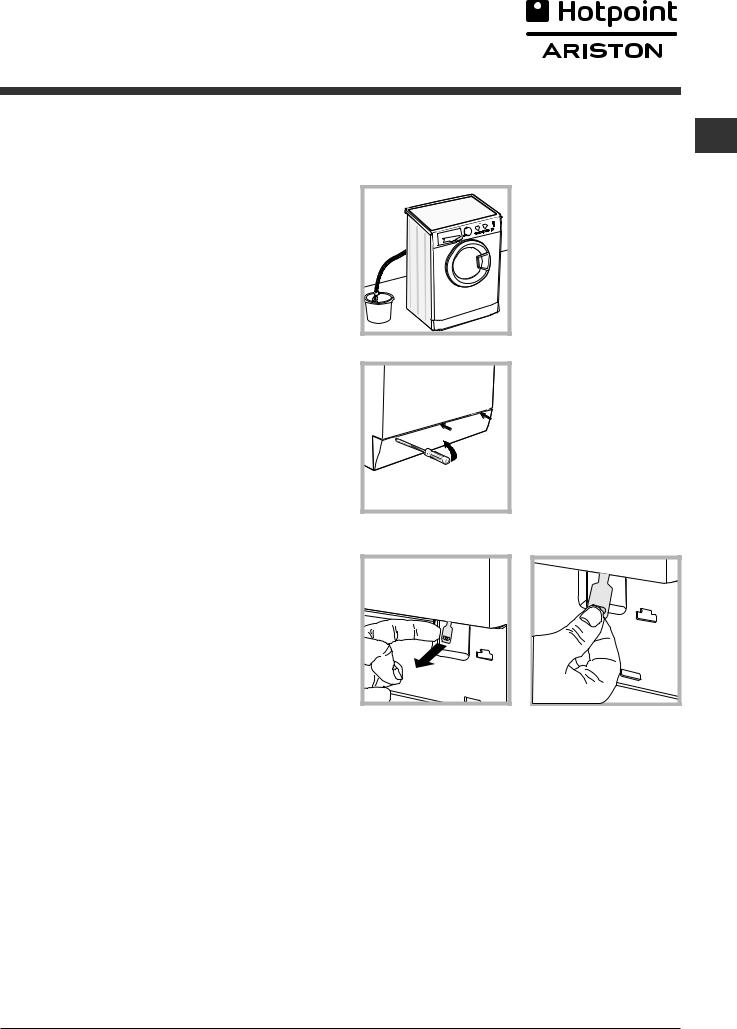
Precautions and tips
! This washing machine was designed and constructed in accordance with international safety regulations. The following information is provided for safety reasons and must therefore be read carefully.
General safety
•This appliance was designed for domestic use only.
•This appliance can be used by children aged
from 8 years and above and persons with reduced physical, sensory or mental capabilities or lack of experience and knowledge if they have been given supervision or instruction concerning use of the appliance in a safe way and understand the hazards involved. Children shall not play with the appliance. Cleaning and user maintenance shall not be made by children without supervision.
•Do not touch the machine when barefoot or with wet or damp hands or feet.
•Do not pull on the power supply cable when unplugging the appliance from the electricity socket. Hold the plug and pull.
•Do not open the detergent dispenser drawer while the machine is in operation.
•Do not touch the drained water as it may reach extremely high temperatures.
•Never force the porthole door. This could damage the safety lock mechanism designed to prevent accidental opening.
•If the appliance breaks down, do not under any circumstances access the internal mechanisms in an attempt to repair it yourself.
•Always keep children well away from the appliance while it is operating.
•The door can become quite hot during the wash cycle.
•If the appliance has to be moved, work in a group of two or three people and handle it with the utmost care. Never try to do this alone, because the appliance is very heavy.
•Before loading laundry into the washing machine, make sure the drum is empty.
Disposal
•Disposing of the packaging materials: observe local regulations so that the packaging may be re-used.
•The European Directive 2012/19/EU on Waste Electrical and Electronic Equipment, requires that old household electrical appliances must not be disposed of in the normal unsorted municipal waste stream. Old appliances must be collected separately in order to optimise the recovery and recycling of the materials they contain and reduce the impact on human health and the environment. The crossed out “wheeled bin” symbol on the product reminds you of your obligation, that when you dispose of the appliance it must be separately collected. Consumers should contact their local authority or retailer for information concerning the correct disposal of their old appliance.
Opening the porthole door manually |
GB |
|
In the event that it is not possible to open the porthole |
||
|
||
door due to a powercut, and if you wish to remove the |
|
|
laundry, proceed as follows: |
|
|
1. remove the plug from the |
|
|
electrical socket. |
|
|
2. make sure the water level |
|
|
inside the machine is lower |
|
|
than the door opening; if it |
|
|
is not, remove excess water |
|
|
using the drain hose, collec- |
|
|
ting it in a bucket as indicated |
|
|
in the figure. |
|
|
3. using a screwdriver, remo- |
|
|
ve the cover panel on the lo- |
|
|
wer front part of the washing |
|
|
machine (see figure). |
|
4.pull outwards using the tab as indicated in the figure, until the plastic tie-rod is freed from its stop position; pull downwards and open the door at the same time.
5.reposition the panel, making sure the hooks are securely in place before you push it onto the appliance.
5

Description of the washing machine and starting a wash cycle
GB |
Control panel |
|
WASH CYCLE PROGRESS/ |
||
|
DELAY TIMER indicator lights |
|
|
SPIN SPEED |
|
|
knob |
DOOR |
|
ON/OFF button |
LOCKED |
|
TEMPERATURE |
|
|
indicator light |
|
|
knob |
|
|
|
|
|
|
|
START/PAUSE |
|
|
|
button with indicator |
Detergent dispenser drawer |
|
FUNCTION |
light |
|
buttons with |
|
|
|
|
|
|
|
WASH CYCLE |
indicator lights |
|
|
|
|
|
|
knob |
|
|
Detergent dispenser drawer: used to dispense detergents and washing additives (see “Detergents and laundry”).
ON/OFF button: switches the washing machine on and off.
WASH CYCLE knob: programmes the wash cycles. During the wash cycle, the knob does not move.
FUNCTION buttons with indicator light: used to select the available functions. The indicator light corresponding to the selected function will remain lit.
TEMPERATURE knob: sets the temperature or the cold wash cycle (see “Personalisation”).
SPIN SPEED knob: sets the spin speed or exclude the spin cycle completely (see “Personalisation”).
WASH CYCLE PROGRESS/DELAY TIMER indicator lights: used to monitor the progress of the wash cycle. The illuminated indicator light shows which phase is in progress.
If the Delay Timer function has been set, the time remaining until the wash cycle starts will be indicated (see next page).
DOOR LOCKED indicator light: indicates whether the door may be opened or not (see next page).
START/PAUSE button with indicator light: starts or temporarily interrupts the wash cycles.
N.B. To pause the wash cycle in progress, press this button; the corresponding indicator light will flash orange, while the indicator light for the current wash cycle phase will remain lit in a fixed manner. If the DOOR LOCKED  indicator light is switched off, the door may be opened. To start the wash cycle from the point at which it was interrupted, press this button again.
indicator light is switched off, the door may be opened. To start the wash cycle from the point at which it was interrupted, press this button again.
Standby mode
This washing machine, in compliance with new energy saving regulations, is fitted with an automatic standby system which is enabled after about 30 minutes if no activity is detected. Press the ON-OFF button briefly and wait for the machine to start up again.
6

Indicator lights
The indicator lights provide important information. This is what they can tell you:
Delayed start
If the DELAY TIMER function has been activated (see “Personalisation”), after the wash cycle has been started the indicator light corresponding to the selected delay period will begin to flash:
As time passes, the remaining delay will be displayed and the corresponding indicator light will flash:
Once the set delay has elapsed, the flashing indicator light will switch off and the selected wash cycle will begin.
Starting a wash cycle
Wash cycle phase indicator lights
Once the desired wash cycle has been selected and has GB begun, the indicator lights switch on one by one to indicate
which phase of the cycle is currently in progress.
Wash
Rinse
Spin
Pump out
End of wash cycle |
END |
Function buttons and corresponding indicator lights
When a function is selected, the corresponding indicator light will illuminate.
If the selected function is not compatible with the programmed wash cycle, the corresponding indicator light will flash and a sound alert (3 beeps); the function will not be activated.
If a function which is incompatible with another function selected previously, only the most recent selection will remain active.
 Door locked indicator light
Door locked indicator light
If this indicator light is on, the appliance door is locked to prevent it from being opened accidentally; to avoid any damage, wait for the indicator light to switch off before you open the appliance door.
N.B. If the DELAY TIMER function is activated, the door cannot be opened; pause the machine by pressing the START/PAUSE button if you wish to open it.
! If the START/PAUSE indicator light (orange) flashes rapidly at the same time as the function indicator light, this indicates a problem has occurred (see “Troubleshooting”).
1.Turn the washing machine on by pressing the ON/OFF button. All the indicator lights will turn on for a few seconds, then only the indicator lights relative to the selected programme settings will remain lit and the START/PAUSE indicator light will flash.
2.Load the laundry and close the door.
3.Set the WASH CYCLE knob to the desired programme.
4.Set the washing temperature (see “Personalisation”).
5.Set the spin speed (see “Personalisation”).
6.Measure out the detergent and washing additives (see “Detergents and laundry”).
7.Select the desired functions.
8.Start the wash cycle by pressing the START/PAUSE button and the corresponding indicator light will remain lit in a fixed manner, in green.
To cancel the set wash cycle, pause the machine by pressing the START/PAUSE button and select a new cycle.
9.At the end of the wash cycle the
 indicator light will switch on. The DOOR LOCKED indicator light will switch off, indicating that the door may be opened. Take out your laundry and leave the appliance door ajar to make sure the drum dries completely. Switch the washing machine off by pressing the ON/OFF button.
indicator light will switch on. The DOOR LOCKED indicator light will switch off, indicating that the door may be opened. Take out your laundry and leave the appliance door ajar to make sure the drum dries completely. Switch the washing machine off by pressing the ON/OFF button.
7
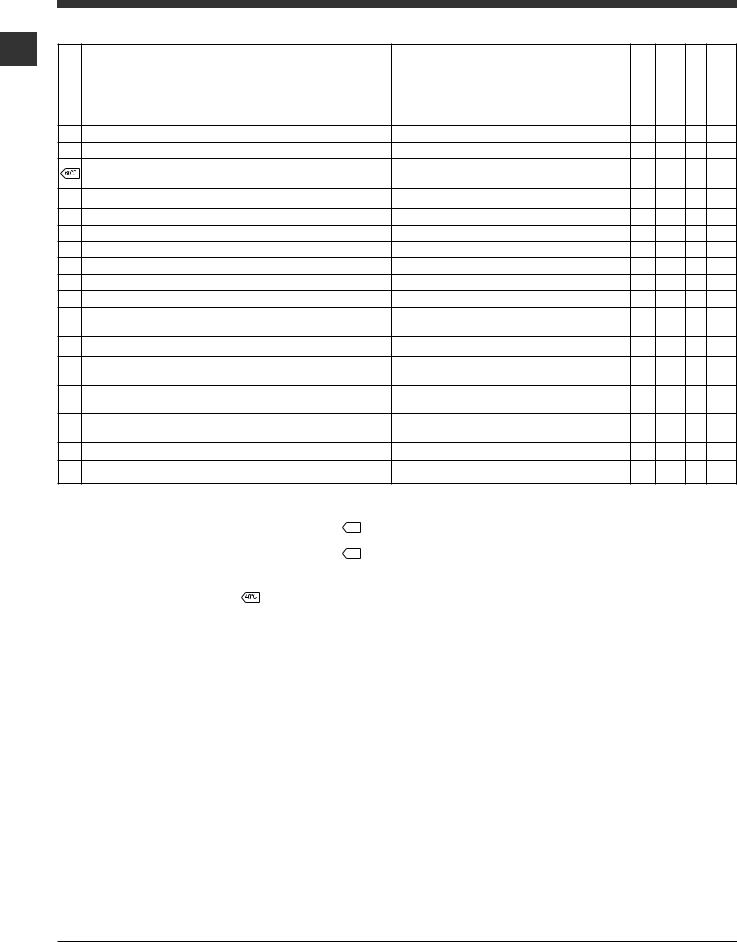
Wash cycles
Table of wash cycles
GB
cycles |
Description of the wash cycle |
|
Wash |
||
|
||
1 |
Anti Stain |
|
2 |
Whites |
|
|
Cotton Standard 60° (1): heavily soiled whites and resistant colours. |
 Cotton Standard 40° (2): lightly soiled resistant and delicate colours.
Cotton Standard 40° (2): lightly soiled resistant and delicate colours.
5Synthetics: heavily soiled resistant colours.
5Synthetics (4): lightly soiled resistant colours.
6 Anti allergy
7 Baby
8 Wool: for wool, cashmere, etc.
9 Delicates
10Fast Wash 60’: to refresh normal soiled garments quickly (not suitable for wool, silk and clothes which require washing by hand).
11 Cotton Standard 20°: lightly soiled resistant and delicate colours.
12 Eco Cottons
13 Eco Synthetics
14 Eco Fast 30’
 Rinse
Rinse
 Spin and Pump out
Spin and Pump out
|
|
|
Detergents |
|
||
Max. |
Max. |
|
|
|
|
|
Prewash |
|
Wash |
Bleach |
Fabric softener |
||
temp. |
speed |
|
||||
|
|
|
|
|
||
(°C) |
(rpm) |
|
|
|
|
|
40° |
1000 |
|
|
|
|
|
60° |
1000 |
|
|
|
- |
|
60° |
1000 |
(3) |
|
|
|
|
(Max. 90°) |
|
|||||
40° |
1000 |
- |
|
|
|
|
60° |
800 |
|
|
|
|
|
40° |
800 |
|
|
|
|
|
60° |
1000 |
- |
|
|
- |
|
40° |
1000 |
|
|
|
|
|
40° |
800 |
- |
|
|
- |
|
30° |
0 |
- |
|
|
- |
|
60° |
1000 |
- |
|
|
- |
|
20° |
1000 |
- |
|
|
|
|
Cold |
1000 |
- |
|
|
- |
|
Water |
|
|||||
|
|
|
|
|
|
|
Cold |
800 |
- |
|
|
- |
|
Water |
|
|||||
|
|
|
|
|
|
|
Cold |
800 |
- |
|
|
- |
|
Water |
|
|||||
|
|
|
|
|
|
|
- |
1000 |
- |
|
- |
|
|
- |
1000 |
- |
|
- |
- |
- |
|
|
|
|
|
|
|
Max. load (kg) |
Residual dampness% |
Energy consumptionkWh |
Total water lt |
Cycle duration |
5 |
- |
- |
- |
180’ |
5 |
- |
- |
- |
180’ |
8 |
62 |
1.04 |
55 |
215’ |
862 0.87 81 185’
4.546 1.03 60 115’
4.5 |
46 |
0.50 |
55 |
100’ |
5 |
- |
- |
- |
195’ |
5 |
- |
- |
- |
145’ |
2 |
- |
- |
- |
90’ |
1 |
- |
- |
- |
80’ |
3.5 |
62 |
0.84 |
44 |
60’ |
8 |
- |
- |
- |
175’ |
8 |
62 |
0.20 |
65 |
80’ |
3 |
48 |
0.12 |
37 |
70’ |
3 |
71 |
0.10 |
36 |
30’ |
8 |
- |
- |
- |
36’ |
8 |
- |
- |
- |
16’ |
The length of cycle shown on the display or in this booklet is an estimation only and is calculated assuming standard working conditions. The actual duration can vary according to factors such as water temperature and pressure, the amount of detergent used, the amount and type of load inserted, load balancing and any wash options selected.
1) Test wash cycle in compliance with directive 1061/2010: set wash cycle 
 with a temperature of 60°C.
with a temperature of 60°C.
This cycle is designed for cotton loads with a normal soil level and is the most efficient in terms of both electricity and water consumption; it should be used for garments which can be washed at 60°C . The actual washing temperature may differ from the indicated value.
2) Test wash cycle in compliance with directive 1061/2010: set wash cycle 
 with a temperature of 40°C.
with a temperature of 40°C.
This cycle is designed for cotton loads with a normal soil level and is the most efficient in terms of both electricity and water consumption; it should be used for garments which can be washed at 40°C . The actual washing temperature may differ from the indicated value.
3) |
At 60 °C the “Prewash” function cannot be selected. |
|
For all Test Institutes: |
|
|
2) |
Long wash cycle for cottons: set wash cycle |
with a temperature of 40°C. |
4) Long wash cycle for synthetics: set wash cycle 5 with a temperature of 40°C.
Anti Stain: the programme 1 is suitable to heavily-soiled garments with resistant colours. It ensures a washing class that is higher than the standard class (A class). When running the programme, do not mix garments of different colours. We recommend the use of powder detergent. Pre-treatment with special additives is recommended if there are obstinate stains.
Whites: use this cycle 2 to wash white clothes. The programme is designed to maintain the brightness of white clothes over time. Use powder detergent for best results.
Anti allergy: use programme 6 to remove major allergens such as pollen, mites, cat’s and dog’s hair.
Baby: use the special wash cycle 7 to remove the remove the soiling typically caused by babies, while removing all traces of detergent from nappies in order to prevent the delicate skin of babies from suffering allergic reactions. The cycle has been designed to reduce the amount of bacteria by using a greater quantity of water and optimising the effect of special disinfecting additives added to the detergent.
Eco cycles
The Eco Cycles assure energy saving by eliminating the need of heating water and it’s an advantage both to your energy bill and the environment! These innovative Eco programmes (12 Eco Cottons, 13 Eco Synthetics and 14 Eco Fast 30’) are available for various fabrics and different quantity of garment; they have been designed to guarantee a high cleaning action even at low temperature and can be used for lightly to medium soiled loads. Eco Cycles give the best results thanks to an intensified wash action, water optimization and are carried out in the same average time of a standard cycle. For the best washing results with Eco Cycles we recommend the usage of a liquid detergent.
Cotton Standard 20°: the programme 11 ideal for lightly soiled cotton loads. The effective performance levels achieved at cold temperatures, which are comparable to washing at 40°, are guaranteed by a mechanical action which operates at
varying speed, with repeated and frequent peaks.
8

Personalisation
|
|
|
|
|
|
|
|
|
|
|
|
|
|
|
|
|
|
Setting the temperature |
|
||||
GB |
|||||
Turn the TEMPERATURE knob to set the wash temperature (see Table of wash cycles). |
|||||
|
|||||
The temperature may be lowered, or even set to a cold wash ( ). |
|
||||
The washing machine will automatically prevent you from selecting a temperature which is higher than the maximum value |
|
||||
set for each wash cycle. |
|
||||
! Exception: if the |
programme is selected, the temperature can be increased up to a value of 90°C. |
|
|||
Setting the spin speed |
|
||||
Turn the SPIN SPEED knob to set the spin speed for the selected wash cycle. |
|
||||
The maximum spin speeds available for each wash cycle are as follows: |
|
||||
Wash cycles |
Maximum spin speed |
|
|||
Cottons |
1000 rpm |
|
|||
Synthetics |
800 rpm |
|
|||
Wool |
800 rpm |
|
|||
Silk |
drain only |
|
|||
The spin speed may be lowered, or the spin cycle can be excluded altogether by selecting the symbol  .
.
The washing machine will automatically prevent you from selecting a spin speed which is higher than the maximum speed set for each wash cycle.
Functions
The various wash functions available with this washing machine will help to achieve the desired results, every time. To activate the functions:
1.Press the button corresponding to the desired function;
2.the function is enabled when the corresponding indicator light is illuminated.
Note:
-If the selected function is not compatible with the programmed wash cycle, the corresponding indicator light will flash and a sound alert (3 beeps); the function will not be activated.
-If a function which is incompatible with another function selected previously, only the most recent selection will remain active.
 Super Wash
Super Wash
This option offers a high-performance wash due to the greater quantity of water used in the initial phase of the cycle, and due to the increased wash cycle duration, is particularly useful for the removal of stubborn stains. It can be used with or without bleach. If you desire bleaching, insert the extra tray compartment (4) into compartment 1. When pouring in the bleach, be careful not to exceed the “max” level marked on the central pivot (see figure pag. 10).
 Easy iron
Easy iron
By selecting this function, the wash and spin cycles will be modified in order to reduce the formation of creases. At the end of the cycle the washing machine will perform slow rotations of the drum; the EASY IRON indicator light will flash and the
 phase will remain lit in a fixed manner. To end the cycle, press the START/PAUSE button or the EASY IRON button.
phase will remain lit in a fixed manner. To end the cycle, press the START/PAUSE button or the EASY IRON button.
 Prewash
Prewash
If this function is selected, the pre-wash cycle will run; this is useful for removing stubborn stains. N.B.: Put the detergent in the relevant compartment.
 Delay timer
Delay timer
This timer delays the start time of the wash cycle by up to 12 hours.
Press the button repeatedly until the indicator light corresponding to the desired delay time switches on. The fifth time the button is pressed, the function will be disabled.
N.B. Once you have pressed the START/PAUSE button, the delay time may only be decreased if you wish to modify it.
9

Detergents and laundry
|
Detergent dispenser drawer |
|
GB |
||
Good washing results also depend on the correct dose of |
||
|
||
|
||
|
detergent: adding too much detergent will not necessa- |
|
|
rily result in a more efficient wash, and may in fact cause |
|
|
build up on the inside of your appliance and contribute to |
|
|
environmental pollution. |
|
|
! Use powder detergent for white cotton garments, for |
|
|
pre-washing, and for washing at temperatures over 60°C. |
|
|
! Follow the instructions given on the detergent packaging. |
|
|
! Do not use hand washing detergents because these |
|
|
create too much foam. |
B |
A |
MAX |
4 |
|
1 |
3 |
2 |
|
Open the detergent dispenser drawer and pour in the detergent or washing additive, as follows.
compartment 1: Pre-wash detergent (powder)
Before pouring in the detergent, make sure that extra compartment 4 has been removed.
compartment 2: Detergent for the wash cycle (powder or liquid)
If liquid detergent is used, it is recommended that the removable plastic partition A (supplied) be used for proper dosage.
If powder detergent is used, place the partition into slot B. compartment 3: Additives (fabric softeners, etc.)
The fabric softener should not overflow the grid. extra compartment 4: Bleach
Preparing the laundry
•Divide the laundry according to:
-the type of fabric/the symbol on the label
-the colours: separate coloured garments from whites.
•Empty all garment pockets and check the buttons.
•Do not exceed the listed values, which refer to the weight of the laundry when dry: see “Table of wash cycles”.
How much does your laundry weigh?
1 sheet 400-500 g
1 pillow case 150-200 g
1 tablecloth 400-500 g
1 bathrobe 900-1200 g
1 towel 150-250 g
Garments requiring special care
Wool: the wool wash cycle on this Hotpoint-Ariston machine has been tested and approved by The Woolmark Company for washing wool garments labelled as hand washable provided that the garments are washed according to the instructions on the garment label and those issued by the manufacturer of this washing machine. HotpointAriston is the first washing machine brand to be approved by The Woolmark Company for Apparel CarePlatinum for its washing performance and consumption of energy and water. (M1127) 

In UK, Eire, Hong Kong and India the Woolmark trade mark is a Certification trade mark.
Delicates: use programme 9 to wash very delicate garments having strasses or sequins.
We recommend turning the garments inside out before washing and placing small items into the special bag for washing delicates.
Use liquid detergent on delicate garments for best results. To wash silk garments and curtains select cycle 9 and then function  ; the machine will end the cycle while the laundry is soaking and the
; the machine will end the cycle while the laundry is soaking and the  indicator light will flash. To drain the water so that the laundry may be removed, press the START/PAUSE button or the
indicator light will flash. To drain the water so that the laundry may be removed, press the START/PAUSE button or the  button.
button.
Load balancing system
Before every spin cycle, to avoid excessive vibrations and to distribute the load in a uniform manner, the drum rotates continuously at a speed which is slightly greater than the washing rotation speed. If, after several attempts, the load is not balanced correctly, the machine spins at a reduced spin speed. If the load is excessively unbalanced, the washing machine performs the distribution process instead of spinning. To encourage improved load distribution and balance, we recommend small and large garments are mixed in the load.
10

Troubleshooting
|
|
|
|
|
|
|
|
|
|
|
|
|
|
|
|
|
|
Your washing machine could fail to work. Before contacting the Technical Assistance Centre (see “Assistance”), make sure |
|
||||
GB |
|||||
that the problem cannot be solved easily using the following list. |
|||||
|
|||||
Problem: |
Possible causes / Solutions: |
|
|||
|
|||||
The washing machine does not switch on.
The wash cycle does not start.
•The appliance is not plugged into the socket fully, or is not making contact.
•There is no power in the house.
•The washing machine door is not closed properly.
•The ON/OFF button has not been pressed.
•The START/PAUSE button has not been pressed.
•The water tap has not been opened.
•A delayed start has been set (see “Personalisation”).
The washing machine does not take in water (the indicator light for the first wash cycle stage flashes rapidly).
•The water inlet hose is not connected to the tap.
•The hose is bent.
•The water tap has not been opened.
•There is no water supply in the house.
•The pressure is too low.
•The START/PAUSE button has not been pressed.
The washing machine continuously takes in and drains water.
•The drain hose is not fitted at a height between 65 and 100 cm from the floor (see “Installation”).
•The free end of the hose is under water (see “Installation”).
•The wall drainage system is not fitted with a breather pipe.
If the problem persists even after these checks, turn off the water tap, switch the appliance off and contact the Assistance Service. If the dwelling is on one of the upper floors of a building, there may be problems relating to water drainage, causing the washing machine to fill with water and drain continuously. Special anti-draining valves are available in shops and help to avoid this inconvenience.
The washing machine does not drain or spin.
•The wash cycle does not include draining: some wash cycles require the drain phase to be started manually.
•The EASY IRON function has been activated: To complete the wash cycle, press the START/PAUSE button (“Personalisation”).
•The drain hose is bent (see “Installation”).
•The drainage duct is clogged.
The washing machine vibrates a lot during the spin cycle.
The washing machine leaks.
•The drum was not unlocked correctly during installation (see “Installation”).
•The washing machine is not level (see “Installation”).
•The washing machine is trapped between cabinets and walls (see “Installation”).
•The water inlet hose is not screwed on properly (see “Installation”).
•The detergent dispenser drawer is blocked (for cleaning instructions, see “Care and maintenance”).
•The drain hose is not fixed properly (see “Installation”).
The START/PAUSE indicator light (orange) and the function indicator lights flash rapidly.
There is too much foam.
•Switch off the machine and unplug it, wait for approximately 1 minute and then switch it back on again.
If the problem persists, contact the Technical Assistance Service.
•The detergent is not suitable for machine washing (it should display the text “for washing machines” or “hand and machine wash”, or the like).
•Too much detergent was used.
11
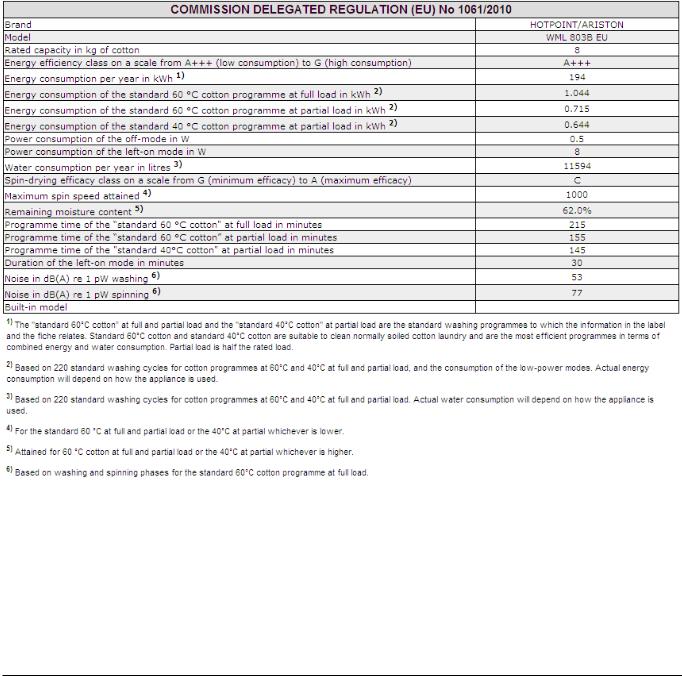
Service
|
|
|
|
|
|
Before calling for Assistance: |
|
GB |
|||
|
• Check whether you can solve the problem alone (see “Troubleshooting”); |
||
|
|
||
|
|
• Restart the programme to check whether the problem has been solved; |
|
|
|||
|
|
• If this is not the case, contact an authorised Technical Assistance Centre using the telephone number provided on the |
|
|
|
guarantee certificate. |
|
|
|
! Always request the assistance of authorised technicians. |
Have the following information to hand:
•the type of problem;
•the appliance model (Mod.);
•the serial number (S/N).
This information can be found on the data plate applied to the rear of the washing machine, and can also be found on the front of the appliance by opening the door.
12

Οδηγίες χρήσης
GR
Ελληνικά
WML 803
ΠΛΥΝΤΗΡΙΟ ΡΟΥΧΩΝ
Περιεχόμενα |
|
|
GR |
||
|
||
Εγκατάσταση, 14-15 |
|
|
|
||
Αποσυσκευασία και οριζοντίωση |
|
|
Υδραυλικές και ηλεκτρικές συνδέσεις |
|
|
Πρώτος κύκλος πλυσίματος |
|
|
Τεχνικά στοιχεία |
|
|
Συντήρηση και φροντίδα, 16 |
|
|
Αποκλεισμός νερού και ηλεκτρικού ρεύματος |
|
|
Καθαρισμός του πλυντηρίου |
|
|
Καθαρισμός του συρταριού απορρυπαντικών |
|
|
Φροντίδα της πόρτας και του κάδου |
|
|
Καθαρισμός της αντλίας |
|
|
Έλεγχος του σωλήνα τροφοδοσίας του νερού |
|
|
Προφυλάξεις και συμβουλές, 17 |
|
|
Γενική ασφάλεια |
|
|
Διάθεση |
|
|
Χειρονακτικό άνοιγμα της πόρτας |
|
|
Περιγραφή του πλυντηρίου και εκκίνηση |
|
|
ενός προγράμματος, 18-19 |
|
|
Πίνακας ελέγχου |
|
|
Ενδεικτικά φωτάκια |
|
|
Εκκίνηση ενός προγράμματος |
|
|
Προγράμματα, 20 |
|
|
Πίνακας των Προγραμμάτων |
|
|
Εξατομικεύσεις, 21 |
|
|
Θέστε τη θερμοκρασία |
|
|
Θέστε το στύψιμο |
|
|
Λειτουργίες |
|
|
Απορρυπαντικά και μπουγάδα, 22 |
|
|
Θήκη απορρυπαντικών |
|
|
Προετοιμασία της μπουγάδας |
|
|
Ειδικά ρούχα |
|
|
Σύστημα ισοστάθμισης του φορτίου |
|
|
Ανωμαλίες και λύσεις, 23 |
|
|
Υποστήριξη, 24 |
|
13

Εγκατάσταση
! Είναι σημαντικό να διατηρήσετε το GR εγχειρίδιο αυτό για να μπορείτε να το
συμβουλεύεστε οποιαδήποτε στιγμή. Σε περίπτωση πώλησης, παραχώρησης ή μετακόμισης, βεβαιωθείτε ότι παραμένει μαζί με το πλυντήριο για να πληροφορεί τον νέο ιδιοκτήτη για τη λειτουργία και τις σχετικές προειδοποιήσεις.
! Διαβάστε προσεκτικά τις οδηγίες: υπάρχουν σημαντικές πληροφορίες για την εγκατάσταση, τη χρήση και την ασφάλεια.
Αποσυσκευασία και οριζοντίωση
Αποσυσκευασία
1. Αποσυσκευάστε το πλυντήριο.
2. Ελέγξτε αν το πλυντήριο έχει υποστεί ζημιές κατά τη μεταφορά. Αν έχει υποστεί ζημιές μην το συνδέετε και επικοινωνήστε με τον μεταπωλητή.
3. Αφαιρέστε τις 4 βίδες προστασίας για τη μεταφορά και το λαστιχάκι με το σχετικό διαχωριστικό, που βρίσκονται στο πίσω μέρος (βλέπε εικόνα).
4.Κλείστε τις οπές με τα πλαστικά πώματα που σας παρέχονται.
5.Διατηρείστε και τα τρία τεμάχια: αν το πλυντήριο χρειαστεί να μεταφερθεί, θα πρέπει να ξαναμονταριστούν.
! Οι συσκευασίες δεν είναι παιχνίδια για μικρά παιδιά.
Ευθυγράμμιση
1. Εγκαταστήστε το πλυντήριο σε ένα δάπεδο επίπεδο και ανθεκτικό, χωρίς να το ακουμπήσετε σε τοίχους, έπιπλα ή άλλο.
2. Αν το δάπεδο δεν είναι απόλυτα οριζοντιωμένο, αντισταθμίστε
τις ανωμαλίες βιδώνοντας ή
ξεβιδώνοντας τα πρόσθια ποδαράκια
(βλέπε εικόνα).Η
γωνία κλίσης, μετρημένη στην
επιφάνεια εργασίας, δεν πρέπει να ξεπερνάει τις 2°.
Μια φροντισμένη οριζοντίωση προσδίδει σταθερότητα στη μηχανή και αποσοβεί δονήσεις, θορύβους και μετατοπίσεις κατά τη λειτουργία. Σε περίπτωση μοκέτας ή τάπητα, ρυθμίστε τα ποδαράκια έτσι ώστε να υφίσταται κάτω από το πλυντήριο αρκετός χώρος για τον αερισμό.
Υδραυλικές και ηλεκτρικές συνδέσεις
Σύνδεση του σωλήνα τροφοδοσίας του νερού
1. Συνδέστε το σωλήνα τροφοδοσίας
βιδώνοντάς τον σε
ένα κρουνό κρύου
νερού με στόμιο σπειρώματος 3/4 gas
(βλέπε εικόνα).
διαυγές.
Πριν τη σύνδεση, αφήστε να τρέξει το νερό μέχρι να γίνει
2. Συνδέστε το σωλήνα τροφοδοσίας
στο πλυντήριο
βιδώνοντάς τον στην
αντίστοιχη είσοδο νερού, στο πίσω μέρος επάνω δεξιά
(βλέπε εικόνα).
3. Προσέξτε ώστε στο σωλήνα να μην υπάρχουν ούτε πτυχώσεις, ούτε στενώσεις. ! Η πίεση νερού του κρουνού πρέπει να
κυμαίνεται μεταξύ των τιμών του πίνακα Τεχνικά στοιχεία (βλέπε σελίδα δίπλα).
! Αν το μήκος του σωλήνα τροφοδοσίας δεν επαρκεί, απευθυνθείτε σε ένα ειδικευμένο κατάστημα ή σε εξουσιοδοτημένο τεχνικό.
! Μη χρησιμοποιείτε ποτέ χρησιμοποιημένους σωλήνες.
! Χρησιμοποιείτε εκείνους που σας παρέχονται με τη μηχανή.
14
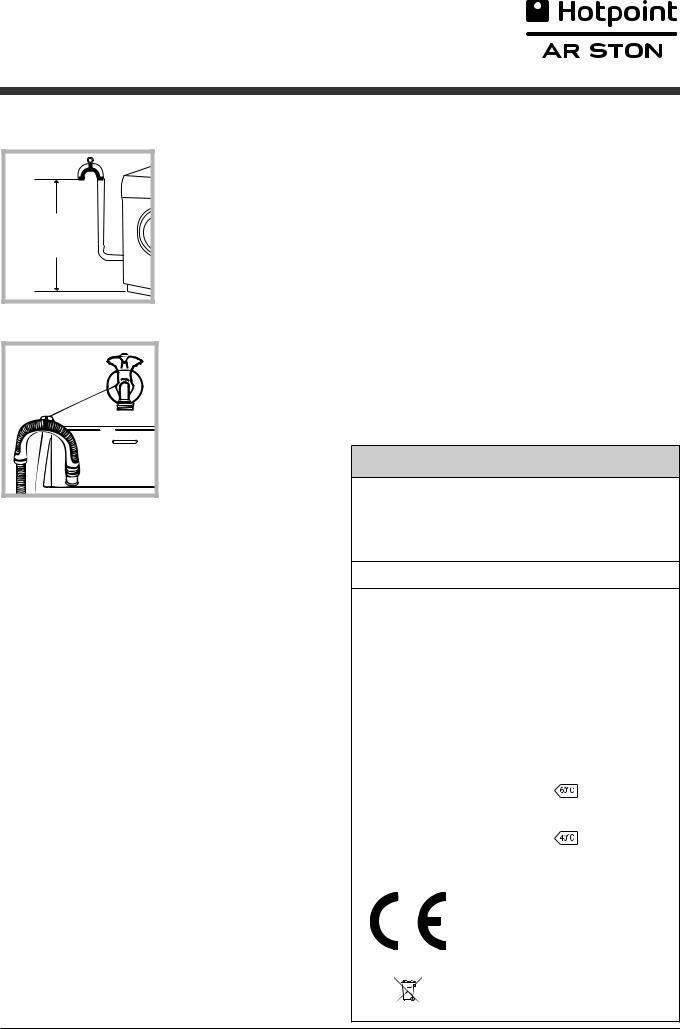
Σύνδεση του σωλήνα αδειάσματος
|
Συνδέστε το σωλήνα |
|
|
αδειάσματος, χωρίς |
|
|
να τον διπλώσετε, |
|
|
σε μια σωλήνωση |
|
65 - 100 cm |
αδειάσματος ή σε |
|
μια παροχέτευση |
||
|
||
|
επιτοίχια σε ύψος |
|
|
από το έδαφος |
|
|
μεταξύ 65 και 100 |
|
|
cm. |
|
|
Ή στηρίξτε τον στο |
|
|
χείλος ενός νιπτήρα |
|
|
ή μιας λεκάνης, |
|
|
δένοντας τον οδηγό |
|
|
που σας παρέχεται |
|
|
στον κρουνό (βλέπε |
|
|
εικόνα). Το ελεύθερο |
|
|
άκρο του σωλήνα |
|
|
αδειάσματος δεν |
|
βυθισμένο στο νερό. |
πρέπει να παραμένει |
|
! Δεν συνιστάται η χρήση προεκτάσεων |
||
σωλήνων. Αν απαιτείται, η προέκταση πρέπει |
||
να έχει την ίδια διάμετρο του αρχικού σωλήνα |
||
και να μην ξεπερνάει τα 150 cm. |
||
Ηλεκτρική σύνδεση
Πριν εισάγετε το βύσμα στην ηλεκτρική πρίζα, βεβαιωθείτε ότι:
• η πρίζα διαθέτει γείωση και τηρεί τις εκ του νόμου προδιαγραφές.
• Η πρίζα να είναι σε θέση να υποφέρει το μέγιστο φορτίο ισχύος της μηχανής, που αναφέρεταιστονπίνακαΤεχνικώνστοιχείων
(βλέπε δίπλα).
• Η τάση τροφοδοσίας να κυμαίνεται μεταξύ των τιμών που αναφέρονται στον πίνακα Τεχνικών στοιχείων (βλέπε δίπλα).
• Η πρίζα να είναι συμβατή με το βύσμα του πλυντηρίου. Σε αντίθετη περίπτωση, αντικαταστήστε την πρίζα ή το βύσμα.
! Το πλυντήριο δεν εγκαθίσταται σε ανοιχτό χώρο,ακόμηκαιανοχώροςείναικαλυμμένος, διότι είναι πολύ επικίνδυνο να το αφήνετε εκτεθειμένο σε βροχή και κακοκαιρία.
|
|
|
|
! Με την εγκατάσταση του πλυντηρίου, η |
|
||
GR |
|||
πρίζα ρεύματος πρέπει να είναι εύκολα |
|||
|
|||
προσβάσιμη. |
|
||
|
|||
! Μη χρησιμοποιείτε προεκτάσεις και |
|
||
πολύπριζα. |
|
||
! Το καλώδιο δεν πρέπει να φέρει πτυχές ή |
|
||
να είναι συμπιεσμένο. |
|
||
! Το καλώδιο τροφοδοσίας πρέπει να |
|
||
αντικαθίσταται μόνο από εξουσιοδοτημένους |
|
||
τεχνικούς. |
|
||
Προσοχή! Η επιχείρηση αποποιείται κάθε |
|
||
ευθύνης σε περίπτωση που δεν τηρούνται |
|
||
αυτοί οι κανόνες. |
|
||
Πρώτος κύκλος πλυσίματος
Μετά την εγκατάσταση, πριν τη χρήση, διενεργήστε ένα κύκλο πλυσίματος με απορρυπαντικό και χωρίς ρούχα θέτοντας το πρόγραμμα “ΑΥΤΌ-ΚΑΘΑΡΙΣΜΟΣ” (βλέπε «Καθαρισμός του πλυντηρίου»).
ФечнйкЬ уфпйчеЯб
МпнфЭлп |
WML 803 |
|
|
|
рлЬфпт cm 59,5 |
ДйбуфЬуейт |
ýøïò cm 85 |
|
вЬипт cm 60,5 |
Чщсзфйкьфзфб áðü 1 Ýùò 8 kg
ЗлекфсйкЭт |
ВлЭре фзн рйнбкЯдб |
||
чбсбкфзсйуфйкюн ерЯ фзт |
|||
ухндЭуейт |
|||
мзчбнЮт |
|
||
|
|
||
|
мЭгйуфз рЯеуз |
|
|
УхндЭуейт |
1 MPa (10 bar) |
||
ЕлЬчйуфз рЯеуз |
|
||
неспэ |
|
||
0,05 MPa (0,5 bar) |
|||
|
|||
|
чщсзфйкьфзфбфпхкЬдпх62лЯфсб |
||
Фбчэфзфб |
мЭчсй 1000 уфспцЭт фп лерфь |
||
уфхшЯмбфпт |
|||
|
|
||
Προγράμματα |
рсьгсбммб |
; κανονικό |
|
ελέγχου |
πρόγραμμα για βαμβακερά |
||
σύμφωνα με |
|||
τις οδηγίες |
στους 60°C. |
|
|
рсьгсбммб |
; κανονικό |
||
1061/2010 |
|||
και |
πρόγραμμα για βαμβακερά |
|||
στους 40°C. |
||||
1015/2010 |
||||
|
||||
|
|
|
З ухукехЮ бхфЮ еЯнбй |
|
|
|
|
уэмцщнз ме фйт бкьлпхиет |
|
|
|
|
КпйнпфйкЭт ПдзгЯет: |
|
|
|
|
- 2004/108/CE |
|
|
|
|
(ЗлекфспмбгнзфйкЮ |
|
|
|
|
Ухмвбфьфзфб) |
|
|
|
|
- 2012/19/EU (WEEE) |
|
|
|
|
- 2006/95/CE (ЧбмзлЮ ФЬуз) |
|
|
|
|
||
|
|
|
||
15
